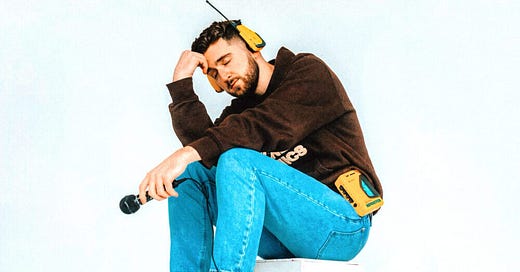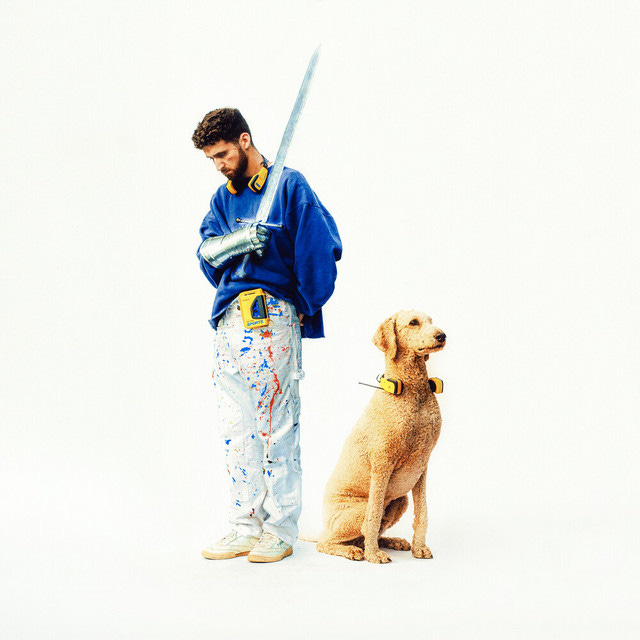Some may know him as the mastermind behind Reach Records’ visual design in recent years, but Kevin Hackett is also a musical artist in his own right. The Canadian artist’s “semi-concept album” INDIGO is the highly anticipated sequel to 2019’s full-length Youth.
This is part 2 of our interview with Hackett. Check out part 1 on the site!
This article originally appeared in Midnight Donuts #5 from October 2024. Want to read the most recent edition of Midnight Donuts? You can do so here!
Midnight Donuts: There’s a ton of features on “CATHARSIS”—I'm curious, was it like, “I want to have so many voices on this song,” or was it like, “well, so-and-so should be here…” and then all of a sudden, you're like, “oh man, there's eight!”
Kevin Hackett: Yeah, the goal was, “I'm gonna throw everybody on this.” Because there's this moment at the end of “BAD DREAMS” (which is like the intro for “CATHARSIS”) where he's like, “but always remember: you are not alone.” And then it's this song with a bunch of people on it. And I think that's special. And I think that's a key part of remembering who you are. …A lot of who you are is defined by the people that you've come across. And I just knew that that moment had to be a collective moment. I wanted group involvement of people who are my friends and people who have been involved in my stuff in the past. I wanted to make this epic squad track.
And I think there's probably like five or six verses that I had to scrap as well from other artists that sent in stuff.
MD: So, Acadia—that's the name of the island—I’m really curious on the process that led to that name.
KH: It's the name of a cabin at Keats, the camp that I worked at.
A lot of the song deals with the feeling of like, “man, this time in my life is going to end soon.” It's not over yet, but it's that feeling of, “I know that this has an end.” … That's what “ACADIA” means.
And I just felt like it was the perfect name for the island. Because I didn't want to call it “Keats,” because the island that the camp takes place on is called Keats. I wanted to do something a bit more creative than that.
MD: I'm just curious to draw out connections [between]... “HOMESICK” and “AMBER.” Because on “AMBER” you say, “I'm running home, but I don't know where I belong.” And then [on] “HOMESICK” you're talking about heading back home.
I also rewatched the “CULDESAC” video today and noticed that there's a piece of paper towards the end that says something like, the album's three acts and the third act is called “Homesick.”
KH: So, home—I'd say even outside of “AMBER” and “HOMESICK” could apply to a lot of songs. … It feels like “home” is like the main thing that I've been trying to lead to. Like, “Icarus” starts with “one day you'll find your way back home.” “CATHARSIS” has the same line without [the word] “home” in it.
I think this whole overarching journey is just about finding that. Where Youth is this story of leaving home and going into this new life, [in INDIGO] I'm clearly away from home, but I need to define myself while I'm on this island. It’s like, I don't know where I'm going to be, but I need to know who I am in order to get there.
At the end of “HOMESICK,” it's like, “let's go, man. We got a long walk home.” And “home,” to me, is just death, if I'm going to put it bluntly. It's the end of life: it's heaven. So, a lot of this stuff is, “before I get there, here's what I want to say. Here's what I want to do.” And that's how I view music a lot of the time. It's what I'm expressing while I'm on my way back home, you know?
MD: The hymn that you said: does that connect back to that?
KH: Yeah, “Jesus, Lover of My Soul…” [It says,] “Hide me, O my Savior, hide / till the storm of life is past / safe into thy haven guide / O receive my soul at last.”
It's very much talking about, when all this is said and done, I hope I'm back home with you, God. So, yeah, it's kind of following my journey a bit. It's like, trying to make it back to God, you know, but also making the most out of the way there.
MD: You're talking about talking to your past self, but there's also a lot of fighting with yourself. I'm thinking of the end of the “TEEN GOSSIP” trailer, in the car in the “CATHARSIS” video, etc. What's up with that?
KH: I think a lot of that is stuff that I'm trying to figure out still. It doesn't really have any place in the actual album. But in the visual world that I'm establishing, I definitely bring that up a lot. I think it is playing on themes of … an internal battle. That's something that I do go through: [trying to] be the best version of myself, versus sometimes feeling like the worst version of myself, you know what I mean? It's not really a lore thing, though. There's not a second version of me in the story. … It's less of a story device and more just a common theme that I really like to play with.
MD: Is there a particular reason for there being a dog on the cover (besides that it just looks awesome)?
KH: Excellent question. The “ACADIA” video was the start of everything in this whole rollout, and the first shot of that was the dog. That was very important to me. I'm like, “I want it to start on [Duster].” I didn't know what it would mean for the future.
Duster also shows up in the “CATHARSIS” video, and he leads me to find the tin can from the “After” video, … and that leads me to that final view of all my old memories. So, in all these things the dog just keeps popping up. I'm like, “dang, this dog is important!”
When it came to the album cover—obviously I went through a lot of iterations of what the album cover should be. That was the hardest part of this whole process: making the album cover. Because that's what people know me as. And I think I put a lot of unrealistic pressure on myself to make this grand image. [Then] I had this moment of like, “what am I doing? Why am I trying to make this insane, vast visual?” I [had been] thinking, like, “I want to show the island Acadia. I want it to be this crazy epic scene.” [But then] I'm like, the album is not about where I am. That's the whole point! … It's about me and who I am.
And so, I'm like, “what if it's just … the best possible portrait representation of me?” The sword being in there, the blue sweater, the paint pants, the cassette tape… I just became set on it [being] a portrait of me.
But then as I was thinking—as I was brainstorming it—I was like, “but I want to represent the island in some way that isn't a place...” And I chose to use Duster, because Duster, in my head, lives on the island—is [at] home on this island. And what better way to represent the island than a being of it?
So yeah, Duster is there to represent Acadia, because that setting is so important. ‘Cause I see him as a friend that I met on this island, you know? … In my head, it adds some weight to leaving the island, too, if you have to leave Duster. … Leaving places can obviously be difficult, but it's a lot harder to leave a place when there's people attached to it—when there's a life attached to it. And so, Duster represents the people in my life, in a sense, as well.
MD: Or at least that added emotional weight.
KH: Yeah, exactly! And honestly, even saying goodbye to my dog—which I had to do in like 2018—I think was like something that hit me so hard emotionally in a way that I didn't expect… I think dogs are a great way to convey an emotional aspect. So, that dog on the cover means a lot to me. It feels like a great picture of this whole album, you know?






